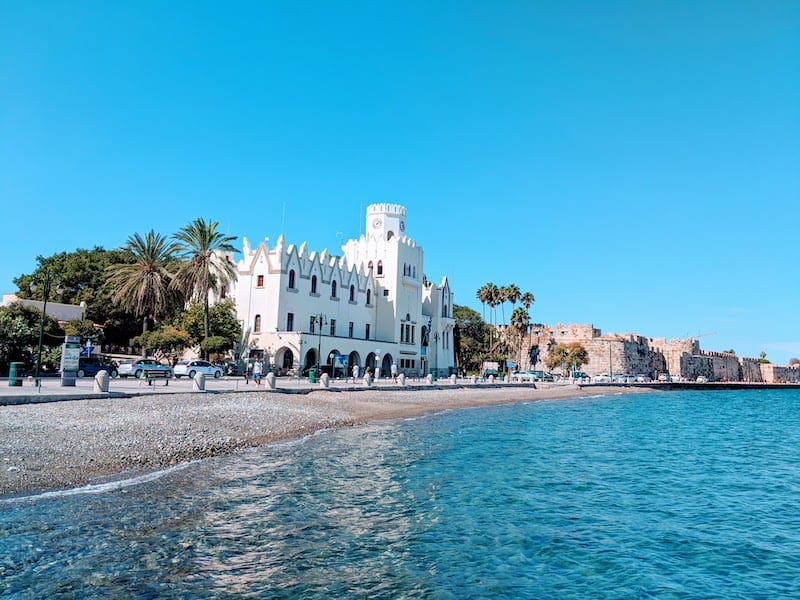Kos Town is the capital of Kos island and one of the main hubs in the Dodecanese islands. It’s an important tourist destination but also has a large year-round local population, commercial zone, and thriving medical industry. Kos Town is an enjoyable place to visit and full of surprises.
Wondering if it’s the right place for you? Read on.
What is Kos Town Like?

I didn’t really know what to expect from Kos Town as I had seen very few photos of it before I visited. I arrived on Kos by ferry on a very humid and hazy day – it felt balmy and tropical. One surprising thing about Kos is that it’s really green and lush thanks to its mountainous interior and volcanic soil.
Some Greek island capitals are functional and full of concrete, not really worth a detour. But Kos Town is definitely worth a visit. Although much of the town’s original architecture was destroyed in various earthquakes, there are plenty of interesting sights – including ancient ruins and a pocket old quarter.
Kos Town has a feel of easy living, enhanced by its pleasant central harbour which is lined with tall trees, and cycle paths which extend out along the coast in either direction. The heart of the town is modern with many low-rise apartment buildings.
Kos is popular with Germans and Scandinavians as well as Brits. There is a big tourist presence in Kos Town – lots of people choose to base themselves here – but there are enough year-round local residents that it’s not just a tourist ghetto.
That said, the biggest concentration of hotels and tourist amenities is concentrated around the harbour and in the streets to the north which have a tacky feel. The beach here is lined with lively beach clubs, sports bars, and shisha cafes. This part of town caters squarely to the low-budget crowd and some parts can feel a bit shabby. Some buildings were abandoned in the economuc crisis years which hit Kos hard.
What to See and Do in Kos Town?
Kos Town has been an important town since the days of the Ancient Greeks so there’s centuries of history here. Unfortunately not all of it has survived due to the area’s many earthquakes and invasions so it’s not as impressively preserved as Rhodes Old Town.
But there are still enough points of interest spanning the all invading empires (Ancient Greek, Roman, Byzantine, Venetian, Crusader, Ottoman, and 20th century Italian) to occupy you for a day or two, as well as an abundance of shops, cafes, bars, and restaurants.
Here are some of the main attractions in Kos Town:
Neratzia Castle

Neratzia Castle was build by the crusaders to guard the entrance of the harbour in the 14th century and it’s one of the first things you’ll see if you arrive by ferry. It’s impressive from the outside, and inside the walls are the open plan remains of the inner castle.
Unfortunately Neratzia was damaged in the recent 2017 earthquake and the interior remains closed to the public.
A stone bridge connects the fortifications to the main town, and underneath this runs the iconic Palm Tree Avenue.
Harbour

One of Kos’ key attractions is the palm-lined harbour – it’s been an important strategic asset for centuries.
These days the harbour is packed with tourist boats offering day trips and fishing, as well as offering a few spaces for yachts and megayachts (though there’s a bigger marina to the south).
Along the harbour you’ll find a few tour agencies for organising excursions, as well as plenty of cafes, bars, and restaurants. The streets immediately behind the harbour are home to the less salubrious end of the tourist scene – tacky souvenir shops, cheap drinks stores and bars, glaring nail bars and fish spas, and shops flogging fake designer clothes.
Plane Tree of Hippocrates

At the south end of the harbour, where it meets Neratzia Castle, you’ll find the Plane Tree of Hippocrates. Legend has it Hippocrates – the father of medicine – lectured his students underneath this tree.
Despite its striking size, this tree is only 500 years old so it’s not quite the real thing, but it’s a nice spot nonetheless. Just behind it you’ll find a charming cafe.

The narrow streets around here are good for exploring as they are wedged between the castle, the main city council building, and the Agora.
A shady cobbled street called Nafklirou runs alongside the perimeter of Agora into the heart of tourist town. This is a prime tout and tat gauntlet but it looks pretty and there are some good deals on afternoon drinks. At night it merges into Bar Street.
Centre of Town

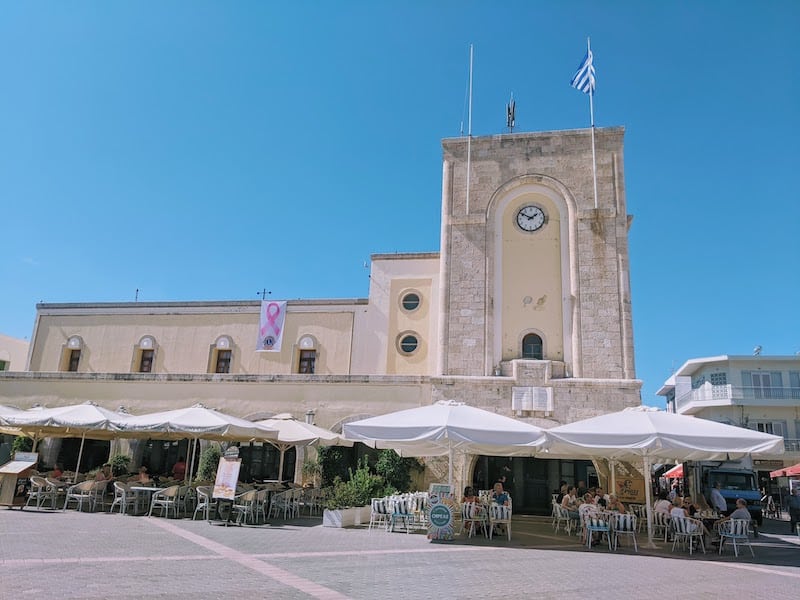
Keep walking up Nafliorou and you’ll reach Eleftherias Square. It means ‘Freedom Square’ and is the centre of local life in Kos Town. It’s where the main commercial streets where merge with the tourist streets. There are lots of cheap fast food joints and banks around here, and you can branch off to walk up along the streets of the Old Town.
Notable landmarks on the square are the mosque (not operational), the market hall, the Archaeological Museum, and the Church of Agia Paraskevi. It’s also on the border of the Ancient Agora.
Old Town

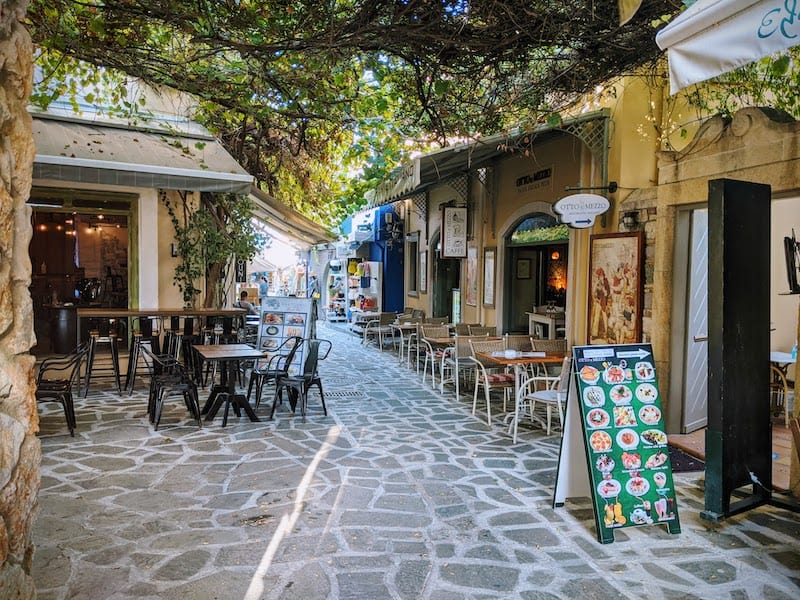
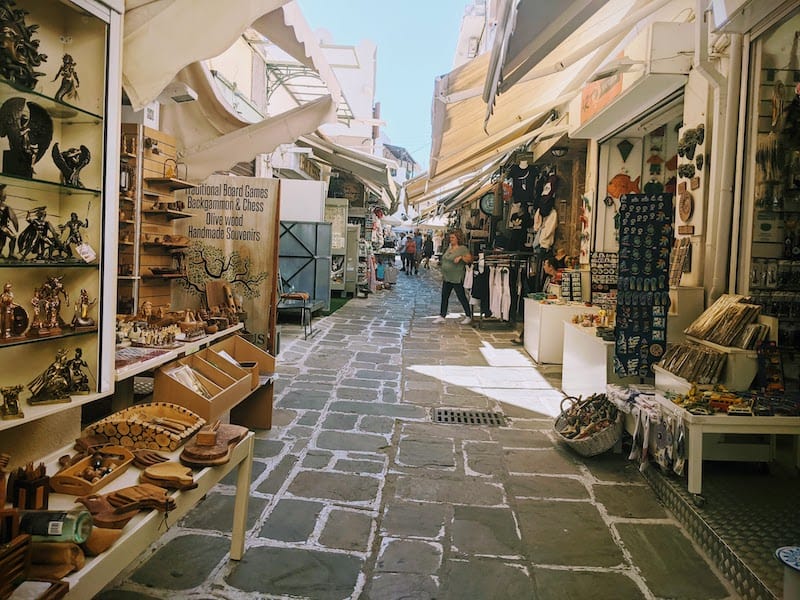
Kos Old Town is a small pedestrianised quarter with awnings and the higher-end tourist shops. Think linen shirts in white and blue, leather sandals, chess sets, and olive wood spoons.
It’s not an extensive area – just two or three streets running north to south. The main impression is of some Byzantine buildings and medieval mosques woven in between more modern buildings.
The zone finishes close to the bus stop where it opens up and around here you’ll find a handful of colourful bougainvillea-strewn tavernas. It’s lively in the evening.

Ancient Agora

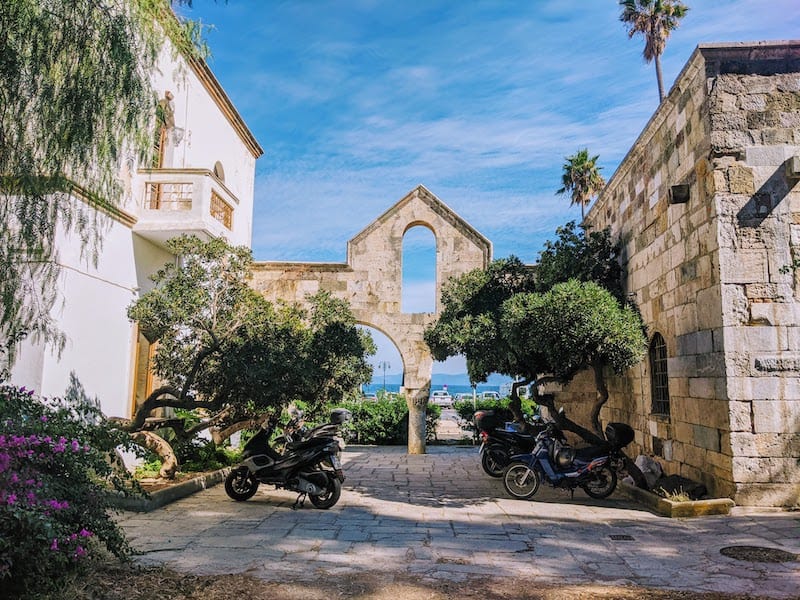
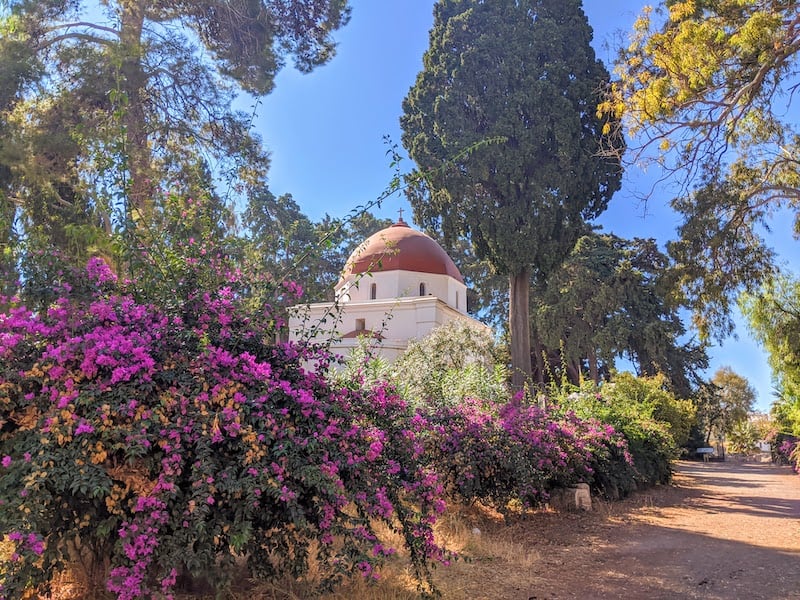
One of Kos Town’s biggest surprises is the extensive ruins at the Ancient Agora. The site is located very centrally, just to the south of Neratzia Castle, and is free to enter. The grounds are filled with overgrown vegetation and tall trees so it makes a pleasant place to wander in the heat of the day. There are information plaques at some of the entrances and around key points of interest.
But the Agora isn’t the only ancient site in Kos Town…
Roman Odeon

You’ll find a small cluster of ancient sites in the area behind the main bus station:
- Roman Odeon – A small 2nd century Roman amphitheatre called the Odeon
- Casa Romana – a restored Roman villas with interesting mosaics (ticket required to enter, not open every day)
- Altar of Dionysus – ruins of a 2nd century altar
And just outside Kos Town you’ll find the ancient site Asklepion which is one of the most popular attractions on the island. It’s not walkable – you can reach it with the city bus or the tourist train, or on one of the many excursions available.
Southern Promenade


Walk south out of the harbour and the road follows the coast for some time. There are some notable rationalist civic buildings which were built during the Italian occupation (1912-1943) after the devastating architecture of 1933.
The most imposing is the large white Government Building (duck behind here to find the Plane Tree).
There’s also an arched entrance leading to the Agora, plenty of shaded cafes, and a cluster of beachfront hotels including the elegant Albergo Gelsomino boutique hotel, pictured below.

South of here is a palm-lined promenade which runs adjacent to the sea. This part of town is home to many hospitals and medical centres, low-rise hotels and apartment blocks, a cinema, and some unfortunately overpriced and bland waterfront cafes. Explore the backstreets for the better cafes and tavernas.
There are also several tour agencies where you can buy ferry tickets and excursions, as well as agencies renting bikes, e-bikes and scooters.
At the end of this stretch of promenade is the modern yacht marina and the area becomes increasingly residential and quiet, with a few large hotels aimed at the windsurfing crowd.

What are the Best Beaches near Kos Town?

There are a few narrow pebble beaches near the centre of Kos Town but nobody really uses these sections for swimming or bathing as they’re right by the main road.
The first decent section south of the harbour is at the Albergo Gelsomino hotel, where there are several beachfront cafes renting sunloungers. The beach is small and a mix of course sand and pebbles – it’s ok for a day but you wouldn’t base a whole holiday around this beach. It peters out as the coast turns a corner and the stretch of sand next to the promenade is short and scrappy.
The more popular beach is north of the harbour. The sand here is much wider and softer, it’s a dark golden colour with some small pebbles and grit.
This beach extends for miles and is lined with lively beach clubs and bars. Wifi access and charging points are common. It gets less busy but more shingly the further north you go. The middle section is known as Lambi. The far end, near the north coast, is home to some large resort hotels.

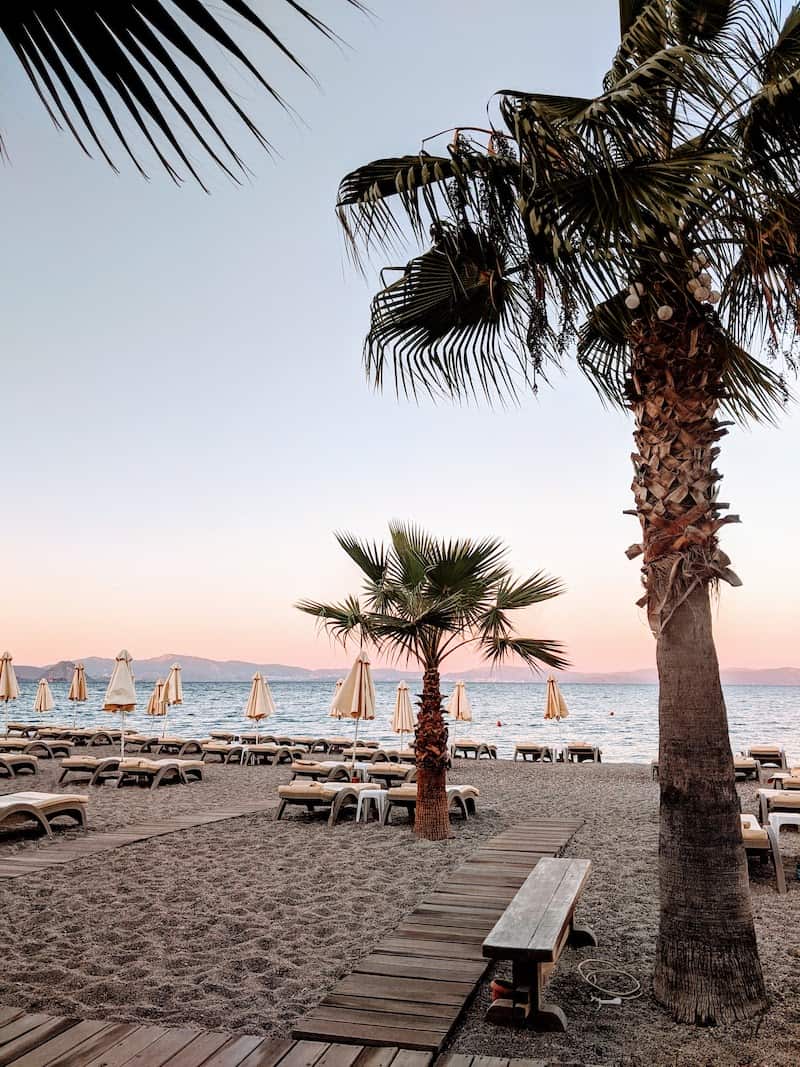
Where to Stay in Kos Town?
Kos Town is substantially bigger than any of the island’s beach resorts and is a popular base for those who like having a variety of things to do, especially given that it has a long beach itself.
There are plenty of budget hotels and cheap package deals to Kos Town. Overall, it’s excellent value compared to other Greek islands.
For something memorable, standouts include:
- Albergo Gelsomino – elegant 5-star boutique beachfront heritage hotel – Check the prices and reviews on Booking.com.
- Diamond Boutique Hotel – lush landscaped 4-star with a pool – Check the prices and reviews on Booking.com
For more suggestions on accommodation see Where to Stay on Kos – Ultimate Beach Resort Guide.
How to Get to Kos Town?

Kos Town is located on the far east coast of Kos.
- From Kos airport: 30 minute drive
- From Tigaki: 15 minute drive
- From Marmari: 20 minutes drive
- From Mastichari: 30 minute drive
- From Kardamena: 40 minutes drive
- From Kefalos: 45 minute drive
By Bus: See KTEL Kos for public bus services to and from Kos Town.
Kos International Airport (KGS) is served by both domestic and international budget and charter airlines – check Skyscanner for deals.
See Ferryhopper for local ferry routes and information.
Kos Town has a busy marina – see Marina Reservation for further info.
Read more:
Where to Stay on Kos: Ultimate Beach Resort Guide
Exploring Kos’ Beaches (By Bike and Bus)
How To Get Around Kos Without a Car
10 Most Beautiful Beaches on Kos
Mastichari, the Most Laid-Back Beach Resort on Kos
Enjoyed this post? Click to save to Pinterest:
All images © The Mediterranean Traveller

